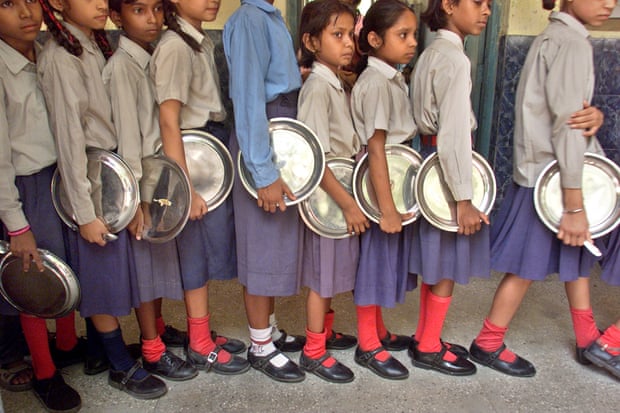More than 100 years have passed since social reformer Margaret McMillan fought for – and won – free school meals in Britain. As a primary school inspector in Bradford, she had seen hunger render poor children unable to learn, robbing them of the promise that came with universal education. The landmark 1906 Education Act provided public funds for meals where children were “unable by reason of lack of food to take full advantage of the education provided”.
That phrase should be at the heart of the agenda for the UN’s Transforming Education summit scheduled for September. Convened by the UN secretary-general, this is the world’s opportunity to tackle a hunger crisis that is jeopardising a recovery in the learning lost during Covid-19 school closures. Yet UN agencies, the World Bank, and governments shaping the summit have failed to grasp the nettle.
Perhaps that’s because hunger among schoolchildren is hidden. Much of the international data focuses on child health during the critical first 1,000 days of life. That has obscured the importance of the 8,000 days it takes for a child to transition to adulthood. Nutrition during the formative primary and adolescent years is critical for health and cognitive development.
Whatever the reason for the neglect, a wake-up call is long overdue. Earlier this month, the Food and Agriculture Organization (FAO) published data on malnutrition rates across developing regions. Applying those rates to schoolchildren captures the deadly interaction of poverty and food price inflation. In sub-Saharan Africa and south Asia, the global centres of child hunger, there were almost 180 million children aged five to 18 who experienced under-nutrition in 2021 – a 76 million increase over pre-pandemic levels. One quarter of Africa’s schoolchildren are now trying to learn while coping with hunger.
The reality is almost certainly worse than the numbers indicate. FAO data does not yet include the food price inflation triggered by the Ukraine war. Wealth and gender disparities also weigh heavily. Fewer than half of adolescent girls in south Asia receive an adequate dietary intake. Micronutrient deficiencies, and anaemia – a major barrier to learning – are endemic. In Africa, poor nutrition is a leading cause of ill-health among primary age children and adolescents from poorer households.
Nothing destroys learning potential as savagely as hunger. Malnourished children are less able to concentrate and absorb information. They are also more likely to drop out of school, partly because they are not learning – and partly because poverty pushes the poorest children into labour markets and child marriage.

School meal programmes can help reverse the downward spiral. Feeding children in school can protect them from malnutrition, increase enrolment, reduce dropout rates and improve learning. Evidence from India’s midday meal scheme shows children of women who participated when they were at school are less likely to be stunted.
Much of the infrastructure for delivering school meals is already in place. Before the pandemic, these programmes represented the world’s largest safety net, reaching more than 300 million children in the poorest countries.
The pandemic dramatically changed this picture. Classroom closures cut the nutritional lifeline provided by school meals, leaving many children without their main – or only – meal of the day. The fiscal space available to governments trying to restore and expand the programmes has shrunk with slower growth, reduced tax revenues and unsustainable debt. Education budgets have been cut in two-thirds of the poorest countries.
As schools have reopened, children have returned carrying the double burden of lost learning and increased hunger. The World Bank estimates that 70% of 10-year-olds could now be living in “learning poverty”, unable to read a simple story, up from 53% before the pandemic. One study after another has documented a deterioration in learning coupled with rising inequality. Dropout rates have started to increase in many countries, with adolescent girls facing higher risks.
Restoring the momentum behind school meal provision could change this picture. It would take about $5.8bn (£4.8bn) a year to reach an additional 73 million children. This is an investment that could protect children from hunger, restore learning, and support the budget of households living in extreme poverty. It would also represent value for money: every $1 invested would generate another $9 in benefits, according to one study. Yet major donors have shunned aid for school meals – and the World Bank, the largest source of development finance for the poorest countries, has no school meals strategy.
Which brings us back to the summit. Last month, the UN organised a preparatory jamboree bringing together dozens of governments, UN agencies, and NGOs to “rethink and reimagine” the purpose of education, reflect on evidence and table solutions. What emerged was less an agenda for action than a stream of consciousness devoid of financing commitments and strategies for delivery. Margaret McMillan would have been turning in her grave.
There will be no transformation of education without a credible response to the hunger crisis. Children at the sharp end of that crisis don’t need another talking shop. They need a properly financed plan of action to deliver what every parent reading this article would demand for their child – a chance to learn in freedom from hunger.
Stay connected with us on social media platform for instant update click here to join our Twitter, & Facebook
We are now on Telegram. Click here to join our channel (@TechiUpdate) and stay updated with the latest Technology headlines.
For all the latest Education News Click Here
